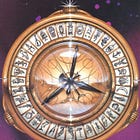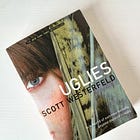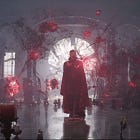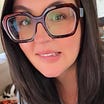For this edition of Speculating on Fiction, we are so excited to introduce guest writer
. Haley is a professional writer and independent scholar who earned her PhD in literary studies in 2021, and now writes on Substack at Closely Reading, where she hosts read-alongs featuring beloved classic authors like Edith Wharton, and shares weekly essays on literary-ish topics.The first essays I read by Haley were 'something resembling gumption' (about The Holiday) and 'green apples and destiny' (about Sleepless in Seattle), and I was completely floored, not only by her inclination to take seriously the often dismissed genre of rom-coms, but also by her brilliant insights and gorgeous writing. I then followed her read-alongs of The House of Mirth and The Age of Innocence, and my admiration for Haley only grew. I highly encourage you to visit these essays after you read today's newsletter.
In Haley's guest post for today’s Speculating on Fiction essay, she writes about the book Borne by Jeff Vandermeer, a dystopian book about an unnamed city dominated by a giant bear. Despite its odd premise, the book explores what it means to be human — Haley writes about this book, and the broader genre of speculative fiction, and what it can do for us.
*This essay contains minor spoilers for Borne.
Being Borne
On a particularly cold day in the nothing-time between Christmas Eve and New Year’s Day in 2018, I opened the front cover of Jeff Vandermeer’s Borne. I wanted to spend an hour or two reading before sinking into other forms of holiday laziness. But something happened about halfway through the first page of the novel — and I didn’t move for hours.
The something that happened was, to put it simply, the magic of speculative fiction taking a firm grip over my attention span and refusing to let go.
“I found Borne on a sunny gunmetal day when the giant bear Mord came roving near our home. To me, Borne was just salvage at first. I didn’t know what Borne would mean to us. I couldn’t know that he would change everything.”
— the first lines of Borne, 2017.
In fact, when I look back at that invigorating 36-hour period in which I read the entire novel without stopping (except for a few necessary breaks for things like food or sleep), I think the magic of the novel had started working on me from the moment I bought it. I’d been drawn to the bizarre abstract art on the cover.
Wondrous imagery
The copy of the novel that I have — a paperback with a gorgeous spot UV design of intricate splatters and slashes laid over a bizarre and colorful Surrealist image — was designed by Abby Kagan with “bestiary illustrations” by Eric Nyquist.
A scaly, winged, glossy, feathered thing perches on the cover, a mess of colors and patterns, inlaid with a vague skull or fossilized pattern that, at certain angles, looks like angry claw marks or a frog’s skin. The overall effect is captivatingly strange — the kind of artwork you might expect in a museum exhibit, especially the “bestiary illustration” of the central figure, which seems to have legs or a trunk or a waterfall of some kind. There is no discernible reason to the figure: it has no face or limbs; it lacks a gaze to meet with my own. Is it a thing or an animal? Is it alive?
From the moment I saw it on the shelf, Borne made me wonder.
This is the particular magic of speculative fiction: that amorphous, weird genre that persistently asks us a wildly enticing question: what if?
What if a hotter-than-usual climate causes a fungal mutation that transforms human beings into violent, bloodthirsty zombies with mushrooms growing out of their heads?
What if dino DNA could be sucked out of fossilized mosquitoes and used to recreate the largest creatures this planet has ever seen to the dismay of good scientists everywhere?
What if, at the end of the world, a group of traveling actors and musicians and artists got together and performed Shakespeare for the dwindling masses across the Great Lakes region?
These questions are taken up in some of my other favorite works of speculative fiction, where the world we know is turned squarely on its head — rendering the familiar unfamiliar and the known unknown.
Borne asks somewhat familiar questions about the end of the world: what if gluttony went completely unchecked? What if bad scientists, owned by corporations and lacking any evidence of education in philosophy or ethics, got free reign to destroy the planet? What kinds of creatures, from the undead to the technological, would emerge from apocalyptic chemical ruin?
Borne was also asking “what if” questions from a different angle.
“What is this thing?” I asked Wick, who was taking a good long look at what I’d brought. The thing pulsed, as harmless and functional as a lamp. Yet one of the terrors the Company had visited on the city in the past was to test its biotech on the streets. The city turned into a vast laboratory and now half destroyed, just like the Company.
“What isn’t it? That’s the first question,” he said.”
— from Borne, part 1.
What isn’t it? In a dangerous, packed world of a “ruined city,” filled with “roving gangs and escaped, altered creatures of unknown origin or intent,” the narrator Rachel — a 28-year-old woman — and her partner Wick are constantly rooting and scavenging through the detritus of their broken world to find anything they can use to continue surviving. Rachel has a knack for finding materials to make the powerful drugs Wick has learned to create, which offer brief respites and healing from what is, otherwise, a rather grueling and unrewarding existence in a terrible world.
On the fringes of a busted society, Rachel continually confronts the unknown and wonders how to define the things she finds. The questions prompted by her discoveries are increasingly philosophical:
What happens when you don’t have any linguistic or mental categories to define the things you’re encountering?
What does it feel like when the language you thought you knew is spoken in a new way — one that baffles, inspires, and enrages you?
What if you found something incredible and devoted your whole life to it, even loved it, and then realized it could end your entire world?
I found myself racing toward whatever answers Vandermeer, who also wrote the Southern Reach trilogy, might provide—while, at the same time, hoping those answers wouldn’t be too specific or too real.
That’s one of the tricks of truly great fiction, isn’t it? Making you crave resolution while simultaneously never, ever wanting the story to end?
A wonderland apocalypse
In Borne, Rachel has a routine. Each day, she scavenges the terrifying landscape as a mutated bear-monster named Mord, the size of a building, flies along the horizon, collecting the detritus of the fallen world into his thick fur. Sometimes, when he sleeps, Rachel climbs his haunches and scavenges there. It is where she tends to find the most valuable objects.
One day, Rachel finds something remarkable in Mord’s matted, stinking fur: “dark purple and about the size of my fist.” It is a small, living creature. Rachel takes it home and soon becomes its mother-by-proxy, naming it Borne, a name that evokes both the bear-monster from which it is retrieved and the verb that means to carry.
“He was born, but I had borne him,” Rachel says.
Rachel takes Borne to her safest place that evening—the highly secured apartment she shares with Wick, who is angry at her for bringing home what he believes is a trap. She is fleetingly cognizant of the havoc that even the most innocent things can perpetuate in their fallen landscape. And yet, there is something about Borne — something that makes her wonder, something that grips her attention span like a vice and takes up all her mental energy, something like speculative fiction itself — that makes her cling to him despite the horror of which he seems an unwitting harbinger.
“That was the moment I knew I’d decided to trade my safety for something else. That was the moment. And no matter what happened next, I had crossed over into another place, and the question wasn’t who I should trust but who should trust me.”
— from Borne, part 1
The story that follows is one of motherhood in a broken world, where Rachel grapples with questions of responsibility, loyalty, and honesty — and continually confronts the ever-evolving strangeness of this unknowable life-form she calls Borne.
The prose is an undulating sensory overload mirroring the existential questions that ruminate, evolve, explode, and swell in Rachel’s mind as she “raises” Borne. There are splashes of color, ominous technological ruins, funky smells and glowing waste; there are mutant animals and eerie silences and dilapidated buildings with empty swimming pools. There is Rachel. And there is Borne.
Finding your identity at the end of the world
I am not a mother (at least not of human children; I consider my cats family). But as I read the novel, I wondered the types of questions I’ve often imagined that parents must ask themselves all the time: who is this strange little creature? What would I do for my Borne? Where would I draw the line? What changes in Borne would become too much for me to understand? What limits from me would be too much for Borne to accept?
One day, Rachel is followed home by a group of violent little boys who steal Borne and tie her up — torturing her for hours in mundane, stupid ways that leave her bruised and bleeding. Despite her pain, Rachel cannot stop worrying about Borne and hoping, despite all evidence to the contrary, that he will be something less terrifying and violent than these boys. That maybe he can become something, or someone, who makes the world a better place, a safer place. Rachel longs for something I imagine most parents long for: for her beloved child to, as the poet Maggie Smith puts it, “make this place beautiful.”
As Rachel grapples with her desire to keep Borne safe, Borne pushes — roughly, sometimes cruelly — back against her, demanding his freedom and the opportunity to explore the world. As a reader, you’re tugged between understanding Rachel’s fears and her feelings of responsibility for Borne’s safety, even as you can feel that Borne is not like Rachel and that she is definitely not his mother.
Then the point-of-view shifts and the mirror goes funhouse. We get Borne’s perspective.
After being exiled from Rachel’s safehouse as Borne’s deeply violent nature becomes clear, Rachel finds his journal, in which the amorphous creature has somehow learned to write:
“What if I am the only one?
What if I cannot die?
What if no one made me?”
— from Borne, part 2
By giving us access to Borne’s thoughts and feelings, Borne offers a deep, memorable interiority to the strangers of the unknown world. Rather than rooting its narrative perspective only within the protagonist we’re meant to trust from the beginning — her detailed observations make Rachel a perfect lens through which to see this strange world and through which to see Borne—the novel invites us to see that Rachel’s perspective is profoundly limited. To see that, so much more than we have realized, she has failed to describe the magic and power and true strangeness of Borne.
She’s only human.
But Borne, it is so clear, is not.
As she longs for Borne to return home, Rachel gazes out of a high window and sees him, endlessly transforming his shape and identity on the ground below her and something happens inside of her: “There was an indelible, floating moment when I felt as if I was down there, looking out through Borne’s eyes, and not up on the balcony in my own skin.” (from Borne, part 2).
In vibrant and fleeting moments, Vandermeer does with language what Lewis Carroll does with riddles, and we somehow see the world as Borne — a powerful, ever-evolving, non-human, techno-creature — sees it. We realize how limited our own view, our own imagination, has been all along.
An “indelible, floating” moment
Terrifying birds and bugs in colors we’ve never seen before. Massive spaceships filled with technology we’ve never dreamt of. Places in the world, or in other faraway worlds, that teem with magic or power or eternal youth. We read speculative fiction for all these dazzling possibilities — for all the strangeness and unfamiliarity that lights up our imaginations.
Borne lit up parts of me I didn’t know were there, parts I’ve shoved into the shadows or boxed away in a corner. The novel invites me to visit the strangest and most remote places within myself — and to look at them in wonder and warmth, rather than fear or anger. To approach the unknown with curiosity and kindness. To bear the parts of myself that I’ve denied; to be borne in my own radical strangeness.
Speculative novels like Borne offer us a chance to recognize the limitations of our first-person experience. These stories help us wonder with renewed focus: what if I really were someone else? What does the world feel like elsewhere? How does being alive feel in another body? The best speculative fiction offers us these “indelible, floating” moments where our perspective can truly shift—and we can glimpse the strangest parts of our world, and perhaps of ourselves, and look closer rather than look away.
We hope you loved this essay. Below you can visit Haley’s Substack, sign up for her read-alongs, and support her writing:












Thank you so much for the opportunity to share all about "Borne," here! It truly is an exemplary piece of speculative fiction and I'm honored to be part of your series!